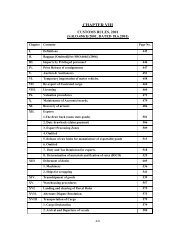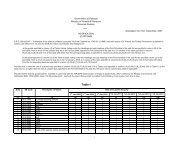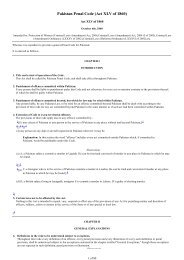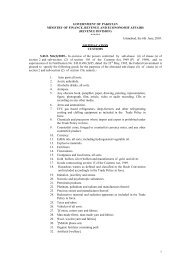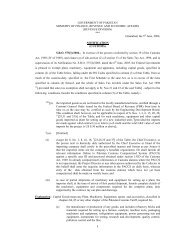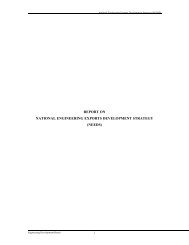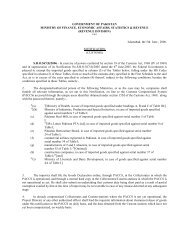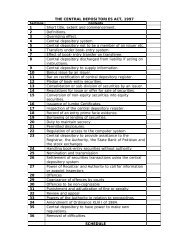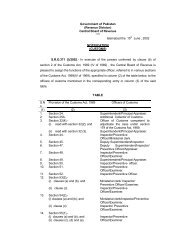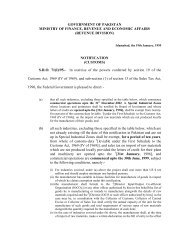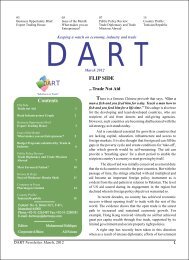47. Pakistan Economic Survey 2011-12 - Consultancy Services in ...
47. Pakistan Economic Survey 2011-12 - Consultancy Services in ...
47. Pakistan Economic Survey 2011-12 - Consultancy Services in ...
Create successful ePaper yourself
Turn your PDF publications into a flip-book with our unique Google optimized e-Paper software.
Public DebtDur<strong>in</strong>g the year 2010-11, servic<strong>in</strong>g of public debtamounted to Rs. 852.2 billion as opposed to abudgeted amount of Rs. 872.9 billion (Table 9.4).The sav<strong>in</strong>g of Rs. 20.7 billion has mostly been dueto stable dollar rupee parity; which reduced theamount used for <strong>in</strong>terest and pr<strong>in</strong>cipal repaymentsof foreign loans <strong>in</strong> Rupee terms. Repayment offoreign loans stood at Rs. 154.2 billion as opposedto a target of Rs. 174.4 billion, while <strong>in</strong>terestpayments on foreign loans, which were budgeted atRs. 76.8 billion, reached Rs 68.4 billion by end-June <strong>2011</strong>. An amount of Rs. 629.7 billion wasspent on account of servic<strong>in</strong>g of domestic debtaga<strong>in</strong>st the budgeted estimate of Rs. 621.8 billion.The <strong>in</strong>crease <strong>in</strong> domestic debt servic<strong>in</strong>g is partlythe result of a tight monetary stance taken <strong>in</strong> orderto arrest the monetary overhang caused byprevious policies. As at the end of March 20<strong>12</strong>,servic<strong>in</strong>g of the public debt stood at Rs. 719 billionaga<strong>in</strong>st the budget amount of Rs. 1,034.2 billion.9.3 Domestic Debt<strong>Pakistan</strong>’s domestic debt comprises permanentdebt (medium and long-term), float<strong>in</strong>g debt (shortterm)and unfunded debt (made up of the various<strong>in</strong>struments available under the National Sav<strong>in</strong>gsScheme) hav<strong>in</strong>g shares of 21.6 percent, 54.5percent and 23.9 percent respectively <strong>in</strong> totaldomestic debt. Banks’ preference of risk-freesovereign credit <strong>in</strong> view of mushroom<strong>in</strong>g nonperform<strong>in</strong>gloans augured well for the governmentsecurities market and overwhelm<strong>in</strong>g participationwas witnessed <strong>in</strong> the auctions of T-Bills, PIBs andGovernment Ijara Sukuk.The composition of major components shap<strong>in</strong>g thedomestic debt portfolio has undergone atransformation from a high dom<strong>in</strong>ance of unfundeddebt to an <strong>in</strong>creas<strong>in</strong>g dependence on float<strong>in</strong>gcomponent of the domestic debt. The unfundedcategory compris<strong>in</strong>g about 44.6 percent of theaggregate domestic debt stock <strong>in</strong> fiscal year 2002has decl<strong>in</strong>ed to 23.9 percent by end March, 20<strong>12</strong>.Contrary to this, the share of float<strong>in</strong>g debt to totaldomestic debt has reached 54.5 percent by end-March 20<strong>12</strong> as compared with 31.4 percent <strong>in</strong>fiscal year 2002 <strong>in</strong>dicat<strong>in</strong>g an over reliance onshorter duration <strong>in</strong>struments i.e. 54.5 percent of thetotal domestic debt has the duration of 0.31 yearsat end March 20<strong>12</strong> which is fairly low ow<strong>in</strong>g tomarket appetite for shorter duration reflect<strong>in</strong>g<strong>in</strong>flationary expectations and higher <strong>in</strong>terest rates<strong>in</strong> the second half of the fiscal year 20<strong>12</strong>. Unduereliance on short-term sources of f<strong>in</strong>anc<strong>in</strong>g raisesthe rollover or ref<strong>in</strong>anc<strong>in</strong>g risk for the government.Failure to issue new debt <strong>in</strong> order to mature a largeamount of outstand<strong>in</strong>g short term debt may triggera liquidity or debt rollover crisis. The <strong>in</strong>crease <strong>in</strong>frequency of such operations (due to their shortterm nature) coupled with any adverse rise <strong>in</strong><strong>in</strong>terest rates may leave the government vulnerableto the high cost of debt. The trends <strong>in</strong> domesticdebt are discussed <strong>in</strong> the follow<strong>in</strong>g graph:Fig-9.3 Trends <strong>in</strong> Permanent, Float<strong>in</strong>g & Unfunded DebtRs. billion37003200270022001700<strong>12</strong>00700200Permanent DebtFloat<strong>in</strong>g DebtUnfunded DebtFY99 FY00 FY01 FY02 FY03 FY04 FY05 FY06 FY07 FY08 FY09 FY10 FY11 FY<strong>12</strong>-Q3<strong>12</strong>9



